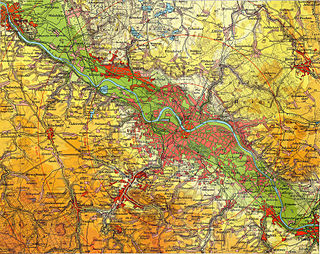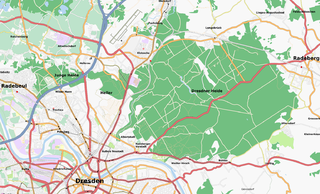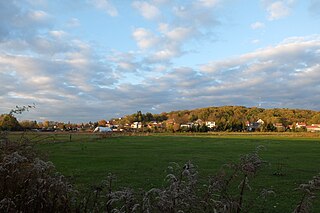| Saxon-Lower Lusatian Heathland | |
|---|---|
| Native Name | Sächsisch-Niederlausitzer Heideland |
| Classification | Natural regions of the Free State of Saxony |
| Natural region | Saxon-Lower Lusatian Heathland |
| State(s) | Saxony |
| Country | Germany |

The Saxon-Lower Lusatian Heathland (German : Sächsisch-Niederlausitzer Heideland) is a natural region in the German state of Saxony. The current natural region division of the Free State of Saxony groups landscape units of the upper geochore or sub-regional level (so-called "macro-geochores") into three "Saxon natural regions" to produce a large-scale classification. These are part of higher order (cross-border) natural regions, whereas the landscape units previously used described areas that were largely confined within the borders of Saxony.

German is a West Germanic language that is mainly spoken in Central Europe. It is the most widely spoken and official or co-official language in Germany, Austria, Switzerland, South Tyrol (Italy), the German-speaking Community of Belgium, and Liechtenstein. It is also one of the three official languages of Luxembourg and a co-official language in the Opole Voivodeship in Poland. The languages which are most similar to German are the other members of the West Germanic language branch: Afrikaans, Dutch, English, the Frisian languages, Low German/Low Saxon, Luxembourgish, and Yiddish. There are also strong similarities in vocabulary with Danish, Norwegian and Swedish, although those belong to the North Germanic group. German is the second most widely spoken Germanic language, after English.
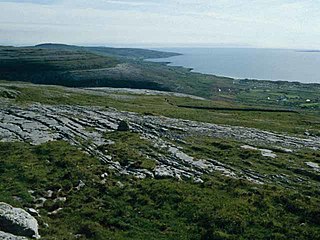
A natural region is a basic geographic unit. Usually it is a region which is distinguished by its common natural features of geography, geology, and climate.

Saxony, officially the Free State of Saxony, is a landlocked federal state of Germany, bordering the federal states of Brandenburg, Saxony Anhalt, Thuringia, and Bavaria, as well as the countries of Poland and the Czech Republic. Its capital is Dresden, and its largest city is Leipzig.
The Saxon-Lower Lusatian Heathland forms the southernmost extent of the North German Plain in eastern Germany. It comprises two separate regions on the northern edge of Saxony and covers about 20% of the state's area. Whilst its boundaries in the north and east are based on political boundaries, due to the limitations of the research and data collation that underpinned the classification, its remaining boundaries are based on physical geographic considerations and are identical with their subordinate natural regions. The western part of the Heathland, roughly between the rivers Mulde and Große Röder, comprises the macro-geochores of the Düben-Dahlen Heath, the Elbe-Elster Lowland and, in the extreme northwest, a small part of the Bitterfeld Mining District, the bulk of which lies in the Saxony-Anhalt and is referred to as the Bitterfeld Mining Region (Tagebauregion Bitterfeld) in the regional landscape planning of that state. [1] The eastern part of the Heathland covers the Königsbrück-Ruhland Heaths, the Upper Lusatian Heath and Pond Landscape, the Upper Lusatian Mining District, the Muskau Heath, the Lusatian Border Wall and, in the extreme north, a small element of the Cottbus Sand Plateau, which lies mainly within the state of Brandenburg. Between the two halves of this natural region is the Großenhainer Pflege, which is counted as part of the Saxon Loess Fields due to its natural regional characteristics.
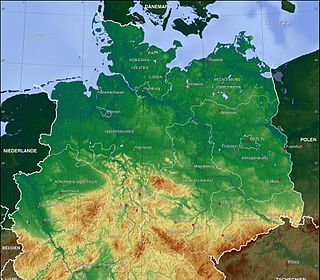
The North German Plain or Northern Lowland is one of the major geographical regions of Germany. It is the German part of the North European Plain. The region is bounded by the coasts of the North Sea and the Baltic Sea to the north and Germany's Central Uplands to the south.

Physical geography is one of the two major sub-fields of geography. Physical geography is the branch of natural science which deals with the study of processes and patterns in the natural environment like the atmosphere, hydrosphere, biosphere, and geosphere, as opposed to the cultural or built environment, the domain of human geography.

The Mulde is a river in Saxony and Saxony-Anhalt, Germany. It is a left tributary of the Elbe and is 124 kilometres (77 mi) long.
Characteristic and unifying features of the natural regions grouped within the Saxon-Lower Lusatian Heathland are soils that are poor in nutrients lying on thick, unconsolidated, Ice Age sediments, with an abundance of groundwater and underground deposits of brown coal. This is a so-called Old Drift landscape, in which erosion and soil-forming processes have been around for a very long time. The surface landforms that arose in the Pleistocene epoch are therefore heavily eroded or even levelled, the soils are heavily decalcified and, in places, strongly acidified. The low agricultural utility across wide areas resulted in a relatively sparse population and, especially in the 20th century, it was extensively used for military training purposes. Large areas also became an industrial landscape as a result of open-cast, lignite mining.

Sediment is a naturally occurring material that is broken down by processes of weathering and erosion, and is subsequently transported by the action of wind, water, or ice or by the force of gravity acting on the particles. For example, sand and silt can be carried in suspension in river water and on reaching the sea bed deposited by sedimentation and if buried, may eventually become sandstone and siltstone.

Groundwater is the water present beneath Earth's surface in soil pore spaces and in the fractures of rock formations. A unit of rock or an unconsolidated deposit is called an aquifer when it can yield a usable quantity of water. The depth at which soil pore spaces or fractures and voids in rock become completely saturated with water is called the water table. Groundwater is recharged from and eventually flows to the surface naturally; natural discharge often occurs at springs and seeps, and can form oases or wetlands. Groundwater is also often withdrawn for agricultural, municipal, and industrial use by constructing and operating extraction wells. The study of the distribution and movement of groundwater is hydrogeology, also called groundwater hydrology.
Old and Young Drift are geographic names given to the morainic landscapes that were formed in Central Europe; the Old Drift during the older ice ages and the Young Drift during the latest glaciations – the Weichselian in North Germany and the Würm in the Alps. Their landforms are quite different. Areas of Old Drift have been heavily flattened and transformed as a result of geomorphic processes such as denudation and erosion, whilst areas of Young Drift have largely retained their original shape. Whilst the majority of Old Drift moraines were formed during the Saale glaciation about 130,000 to 140,000 years ago, the Young Drift moraines in Central Europe are only about 15,000 to 20,000 years old. The terms Old and Young Drift are used for all elements of the glacial series even though the meltwater deposits and landforms are not strictly moraines.
Relatively un-fragmented areas, numerous water bodies and wetland sites and extensive nutrient-poor open land, amongst other features, have led to a high conservation value being placed on the region, which contains about 71% of Saxony's nature reserves.





